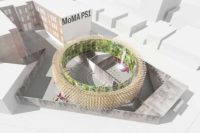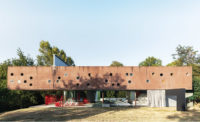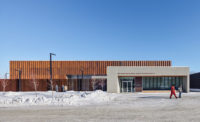Solar-Powered Facility Brings Surgical Services to Rural Uganda

The equatorial town of Kyabirwa sits less than a mile from the Nile River, just north of Lake Victoria.
Photo © Bob Ditty

The facility’s central courtyard allows patients’ family members to wait in the shade.
Photo © Bob Ditty

Each of the 250 photovoltaic panels produces 320 watts. The array charges batteries so that the facility never loses power.
Photo © Bob Ditty



Architects & Firms
On September 17, 2019, around 3 a.m. Eastern Time, a few dozen physicians, architects, and others connected to New York’s Mount Sinai Health System woke up, turned on their computers and phones, and tuned in to a livestream of a hernia-repair surgery in the rural village of Kyabirwa, Uganda. It was the first procedure taking place at a new ambulatory surgery center there. Designed by Kliment Halsband Architects (KHA), the $1.35 million project makes use of technology and design to provide outpatient care to residents of the small East African town near the Nile River.
For much of his career, Mount Sinai’s surgeon- in-chief, Dr. Michael Marin, has been interested in problems with the distribution of surgical care around the world, and particularly in remote communities and developing countries. “Five billion people on our planet can’t get an appendix removed if they develop acute appendicitis, or can’t get a hernia fixed,” he explains. “These are relatively simple operations that we take for granted in our country.” In August 2014, the physician found a donor willing to fund the construction of a surgical center in Africa. He began to discuss broad concepts for such a facility with his son, a designer at KHA in New York. Marin met with founding partner Frances Halsband, who established the firm in 1972 with her husband, the late Robert Kliment. Mount Sinai engaged KHA, and the project broke ground in Kyabirwa in early 2017, officially opening in September of this year.
In many developing countries, Marin says, surgery is often perceived as either too costly or too complicated. “Neither of those things should be limitations,” he says. “It really isn’t too expensive, and it really isn’t that complex. Surgery is just not that hard.” By focusing on relatively simple outpatient procedures (such as gallbladder problems, skin grafts, fractures, or birth injuries), and by having virtual access to specialists from Mount Sinai, the center can maximize its impact and the number of patients it serves.
Halsband and her team (including George George, Simone Meeks, and Max Marin) worked with the New York–based doctor to identify the technical requirements for the 8,000-square-foot building. “We narrowed it down to a very simplified equipment schedule,” says Halsband, “and then we started looking at what could we do in this place, which had no electricity, no water, no internet, nothing.” While she characterizes the town’s existing electrical grid as “completely unreliable,” the site has abundant rain and sunlight—and plenty of leafy banana plants. “The more I looked at these plants, I realized they were absorbing the energy of the sun and also providing shade. I thought, ‘That’s the answer!’ ”
Inspired by the form of the banana plant, the architects designed a canopy of solar panels that provides shade to a large central courtyard. (Entire families often accompany patients to their procedures, since the nursing staff is kept to a minimum at the outpatient-only facility.) Branching, green-painted poles recalling tree trunks support the 80-kW array.
Arranged around the courtyard, the building has space for offices and storage, a preop/ post-op recovery room, and laboratory and diagnostic facilities. The two operating rooms are equipped with cameras and microphones that allow surgeons from Mount Sinai in New York to watch and respond to surgeons in Uganda in real time. (To allow this kind of intercontinental collaboration, the team laid some 20 miles of cable, bringing internet to the site from the nearby city of Jinja.)
The technological integration continues postop: after patients leave, health-care field workers in Kyabirwa visit them at home, taking their vitals, asking follow-up questions, and photographing incisions on their mobile phones. All the information they gather is then uploaded to a medical-records system for the doctors to review. “We hope to show that you can actually bring advanced surgery into rural communities in very underserved parts of the world,” says Marin.
All those involved placed great emphasis on collaborating with the local community. “We did not want to send the message of ‘Americans coming in to build this thing,’ ” says Marin, who has visited Uganda more than a dozen times. “It is their surgical center, and the 50 people who built it all come from here.” KHA’s design called for a steel structure, filled in with clay bricks and clad with kiln-fired tiles manufactured in Jinja using traditional methods. Rainwater is stored in elevated and underground tanks, then filtered and purified for use in sinks. And the facility is home to three of Kyabirwa’s few flush toilets. “I think they’re some of the biggest hits of the hospital,” says Halsband.
The architect sees her firm’s work in Uganda—KHA’s first health-care project—as a framework for future ambulatory surgery centers in the developing world. “We were not trying to create a building that we would just drop in other locations,” Halsband says, “but, rather, a handbook of technical requirements, with the freedom to change how it looks and relates to its context.” Designed for and built by the community it serves, the Kyabirwa Surgical Facility seems well positioned to support local doctors in keeping patients healthy.






